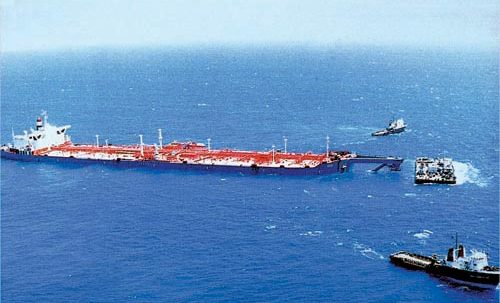Oil spot spotted near decaying laden FSO off Yemen

Saudi Arabia has warned the United Nations it has detected an “oil spot” near the decrepit, abandoned floating storage tanker Safer, a vessel that has been described repeatedly as a potential environmental time bomb in the Red Sea.
The FSO Safer, stranded for the past five years to the north of Yemen’s port city of Hodeidah, contains 157,000 tonnes of light crude oil, four times as much as the amount of oil that gushed into the sea off Alaska from the Exxon Valdez tanker 31 years ago.
In May, seawater leaked into the abandoned FSO’s engine room, which was eventually patched by a team of divers.
Saudi Arabia’s UN Ambassador Abdallah Al-Mouallimi warned this week that experts had discovered 50 km west of the Safer that “a pipeline attached to the vessel is suspected to have been separated from the stabilizers holding it to the bottom and is now floating on the surface of the sea.”
In the UK this week, the shadow international development minister added her voice to growing calls for urgent action to avoid “environmental catastrophe”.
In a letter to her government counterpart, shadow minister Anna McMorrin wrote: “A breach of the tanker and an oil spillage of any magnitude would deepen the world’s gravest humanitarian emergency in Yemen, dealing a significant blow to a country crippled by conflict, Covid-19 and now famine. It would also spark an environmental catastrophe, destroy endangered biodiversity, risk the health of local populations, and deliver a crushing economic and logistical setback to many aid-dependent and fragile states reliant on Red Sea shipping.”
The 44-year-old FSO was owned by the Yemeni government but was seized by the Houthis in 2015. It has been stationed in Yemeni waters for the past 33 years.
Writing for Splash earlier this month, Carlos Luxul, the author of The Ocean Dove, noted of the FSO: “Years of neglect have taken their toll. There are no reliable estimates of the present thickness of the Safer’s hull, but it is not unreasonable to assume that it is down to its last few millimetres in certain places, masked by the presence of a generous coating of marine encrustation.”
Water ingress was also reported on another ageing FSO off Venezuela four weeks ago which is carrying 173,000 tons of oil onboard and is located near Trinidad and Tobago.

 , a vessel that has been described repeatedly as a potential environmental time bomb in the Red Sea.
, a vessel that has been described repeatedly as a potential environmental time bomb in the Red Sea.
There is also a massive lacuna in Maritime law. This is a check-mate that long precedes the catastrophic Mauritius Wakashio fiasco and it seems the global corporate commiserations echo shallow because lessons unlearned have slicked away from the brain like water from a duck’s head. Futhermore, no consolidated environmental marine management has manifested in an international legal response. Yemen is in crisis, global awareness has been diffused and the impasse persists. The substance concerned is toxic and flammable – the sparks are flying overhead and rust corrodes with salt water. I shall keep this concise before my obvious remarks descend into vitriol tinged with overt suspicion. By the way, there is a God who does not need Zoom to attend international power assemblies. Oh. the thought of it!